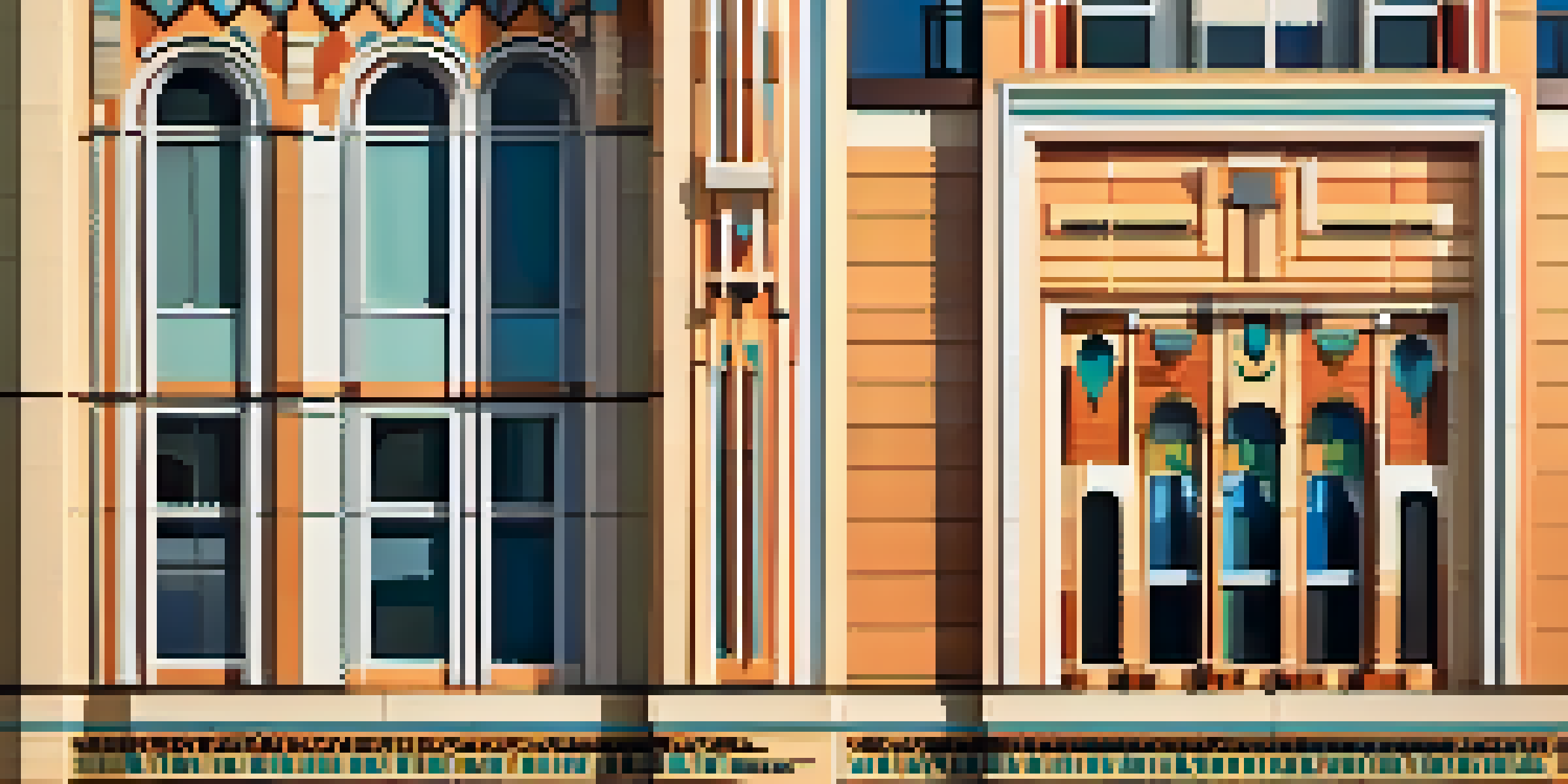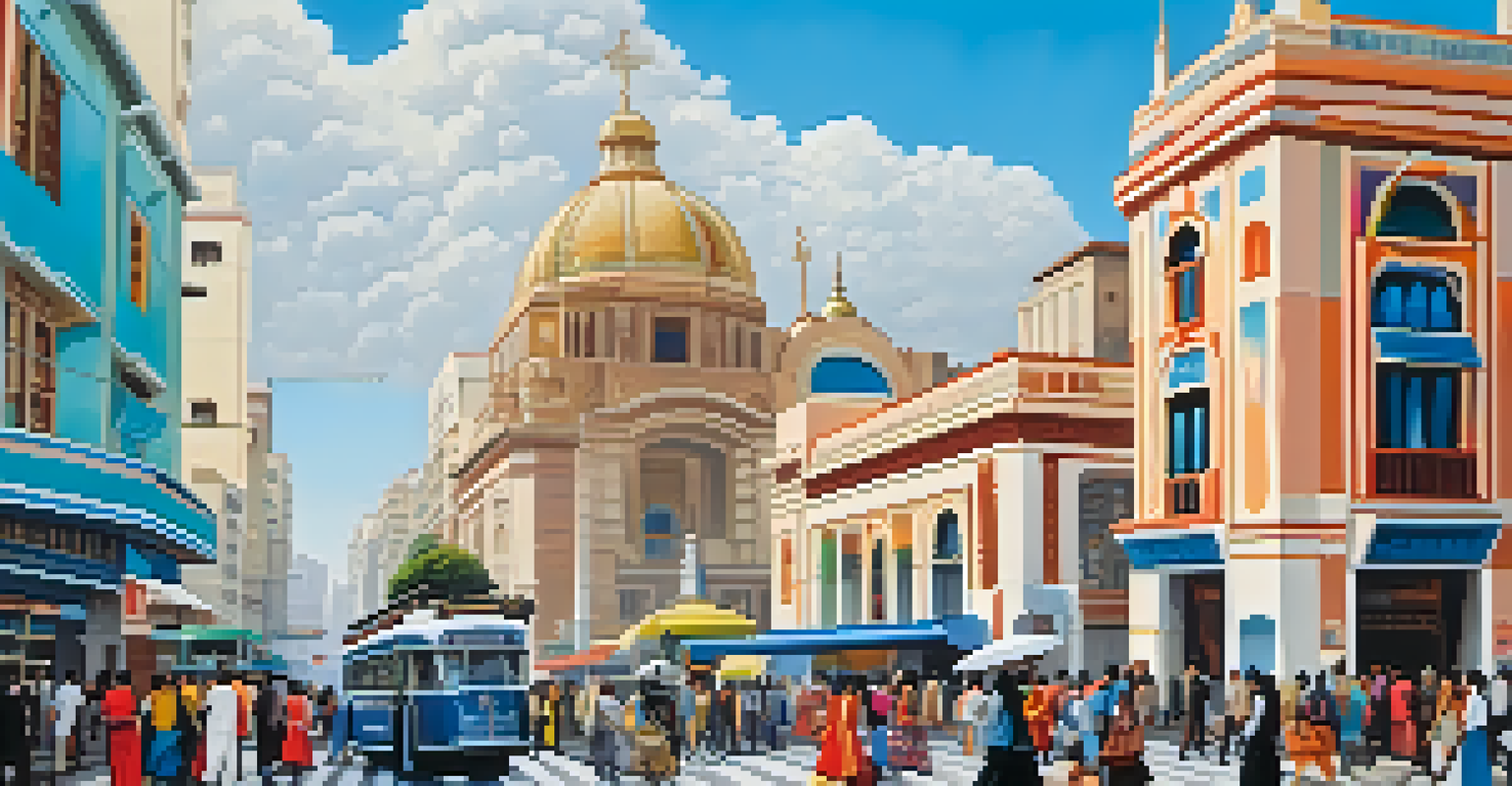Art Deco in Peru: The Rise of Modern Architectural Styles

Introduction to Art Deco and Its Global Influence
Art Deco emerged in the early 20th century, characterized by its bold geometric shapes and vibrant colors. This style was a response to the more ornate designs of previous eras, offering a fresh perspective on beauty and practicality. As global travel and communication expanded, Art Deco began to influence architecture and design across various countries, including Peru.
Architecture is the thoughtful making of space.
In Peru, the Art Deco movement found a unique expression, merging local traditions with modern aesthetics. The result was a distinctive architectural style that reflected both international trends and the rich cultural heritage of the country. This fusion created buildings that were not only visually striking but also deeply rooted in Peruvian identity.
Understanding the global context of Art Deco helps us appreciate its impact on Peru. As cities around the world embraced this modern style, Peru's architectural landscape began to transform, leading to a renaissance of urban design that celebrated both innovation and tradition.
The Historical Context of Peru in the Early 20th Century
The early 20th century was a time of significant change for Peru, marked by economic growth and urbanization. As cities expanded, there was an increasing demand for modern infrastructure and buildings that could cater to a growing population. This period saw the rise of new architectural styles, including Art Deco, which offered a modern alternative to traditional designs.

During this time, Peruvian architects began to experiment with different styles, blending local materials and techniques with international influences. This creative exploration led to the creation of buildings that were not only functional but also visually appealing. The Art Deco movement resonated particularly well in urban centers like Lima, where modernity was embraced.
Art Deco's Unique Influence in Peru
The Art Deco movement in Peru merged local traditions with modern aesthetics, creating a distinctive architectural style that reflects the country's cultural identity.
The historical context of Peru's development set the stage for the Art Deco movement to flourish. With a backdrop of social and economic change, architects found inspiration in both the new and the old, leading to a distinctive architectural identity that would define the era.
Key Characteristics of Art Deco Architecture
Art Deco architecture is known for its distinctive features, including bold geometric shapes, stylized motifs, and vibrant colors. In Peru, these characteristics manifested in various forms, from the intricate ornamentation of facades to the sleek lines of buildings. This visual language conveyed a sense of modernity and sophistication that was appealing to both architects and the public.
The details are not the details. They make the design.
Materials played a crucial role in Art Deco design, with a preference for modern materials like steel and glass. In Peru, local materials were often incorporated, creating a harmonious blend of modernity and tradition. This approach not only showcased the innovative spirit of the time but also celebrated the country’s rich resources and craftsmanship.
Beyond aesthetics, Art Deco architecture often aimed to reflect the values of the society it served. In Peru, this meant creating spaces that were functional and accessible while also inspiring a sense of pride in national identity. The emphasis on beauty and utility made Art Deco a perfect fit for a nation on the brink of modernity.
Notable Art Deco Buildings in Peru
Peru is home to several iconic Art Deco buildings that highlight the movement's influence. One of the most famous is the Palacio de la Exposición in Lima, a stunning example of the style that incorporates both local and international elements. Its intricate details and bold lines make it a must-see for architecture enthusiasts visiting the city.
Another notable example is the Edificio del Banco de la Nación, which stands as a testament to the grandeur of Art Deco design. This building features striking geometric patterns and a commanding presence, reflecting the importance of financial institutions during Peru's modernization. Its design continues to impress both locals and tourists alike.
Key Figures Shaping Peruvian Art Deco
Prominent architects like Juan O’Gorman and Emilio Harth-Terré played a crucial role in adapting Art Deco to Peru, blending global trends with indigenous motifs.
These buildings, along with others scattered throughout the country, showcase the versatility and charm of Art Deco architecture. They serve as reminders of a transformative period in Peru's history, where architecture was not just about utility but also about expressing cultural identity and aspirations.
The Role of Peruvian Architects in Art Deco
Peruvian architects played a pivotal role in the development and adaptation of Art Deco in the country. Figures like Juan O’Gorman and Emilio Harth-Terré were instrumental in introducing and popularizing this architectural style. Their innovative designs helped shape the visual landscape of modern Peru, blending international trends with local sensibilities.
These architects were not afraid to experiment, often incorporating indigenous motifs and local craftsmanship into their Art Deco designs. This fusion created a unique architectural language that resonated with the Peruvian populace, making modernity feel accessible and relatable. Their work reflected a deep understanding of both global architecture and local culture.
The legacy of these Peruvian architects continues to influence contemporary design in the country. By embracing Art Deco, they laid the groundwork for future generations of architects to explore and innovate, ensuring that Peru's architectural identity remains vibrant and evolving.
Art Deco's Influence on Contemporary Peruvian Architecture
The impact of Art Deco on contemporary Peruvian architecture is evident in various modern buildings that draw inspiration from this iconic style. Elements such as geometric patterns, bold colors, and innovative use of materials can be seen in today’s architectural projects. This continuity of design reflects a respect for historical influences while embracing modernity.
Many contemporary architects in Peru are revisiting Art Deco principles, reinterpreting them to fit current needs and aesthetics. This revival not only honors the past but also serves as a source of inspiration for innovative designs that resonate with today's society. The integration of Art Deco elements into new constructions creates a dialogue between history and modernity.
Legacy of Art Deco in Modern Design
The principles of Art Deco continue to inspire contemporary Peruvian architecture, fostering a dialogue between historical influences and modern innovations.
As Peru continues to grow and evolve, the influence of Art Deco remains a significant part of its architectural identity. This enduring legacy serves as a reminder of a time when Peru embraced modernity while staying true to its cultural roots, and it continues to inspire new generations of architects and designers.
Conclusion: The Enduring Legacy of Art Deco in Peru
In conclusion, Art Deco has left an indelible mark on Peru's architectural landscape, shaping the way buildings are designed and perceived. This style represents a unique blend of modernity and tradition, reflecting the aspirations and identity of a nation in transformation. The influence of Art Deco can still be felt today, as architects continue to draw inspiration from its principles.
The legacy of Art Deco in Peru is not just about aesthetics; it encapsulates a period of growth, creativity, and cultural pride. As cities evolve and new architectural trends emerge, the spirit of Art Deco serves as a reminder of the importance of honoring historical influences while embracing innovation. This balance is essential for creating spaces that resonate with both current and future generations.

Ultimately, Art Deco in Peru stands as a testament to the power of architecture to tell stories and shape identities. As we explore the beautiful buildings that emerged from this movement, we celebrate not just the structures themselves, but the rich cultural narrative they embody.